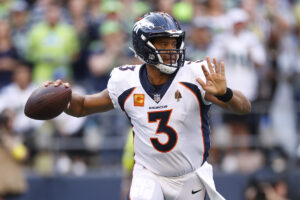Introduction:
Russell Wilson
The seismic shift in the NFL landscape following Russell Wilson’s departure from the Seattle Seahawks to join the Denver Broncos left fans and analysts alike reeling. This blockbuster move ignited debates, speculation, and questions surrounding who bears the responsibility for the fallout. In this analysis, we dissect the factors contributing to the Wilson-Broncos saga, identifying key stakeholders and their roles in shaping this high-profile departure.
Understanding the Dynamics: Before delving into assigning blame, it’s essential to comprehend the dynamics leading up to Russell Wilson’s departure. Wilson’s tenure with the Seahawks was marked by exceptional performances, leading the team to multiple playoff appearances and a Super Bowl victory. However, tensions began brewing, with reports surfacing about Wilson’s discontent with the team’s direction and his desire for more control over offensive strategies.
Key Players Involved:
- Russell Wilson: As the face of the Seattle Seahawks franchise for a decade, Wilson’s dissatisfaction with the team’s performance and his aspirations for greater influence are pivotal factors in the fallout. His public statements and behind-the-scenes negotiations shaped the trajectory of his departure.
- Seattle Seahawks Management: The Seahawks’ front office, led by general manager John Schneider and head coach Pete Carroll, played a crucial role in managing Wilson’s grievances and attempting to retain him. However, their handling of team dynamics and inability to fully address Wilson’s concerns may have accelerated his departure.
- Denver Broncos: Emerging as the ultimate destination for Wilson, the Broncos capitalized on the opportunity to acquire a proven quarterback talent. Their aggressive pursuit and ability to meet Wilson’s demands showcase their proactive approach to bolstering the team’s roster.
- NFL Franchise Dynamics: Beyond individual teams, the broader dynamics within the NFL, including salary cap constraints, player empowerment, and the competitive landscape, influenced the fallout. These factors shaped the bargaining power of both Wilson and the Seahawks, ultimately impacting the outcome.
Analyzing the Fallout: Now, let’s dissect the factors contributing to the fallout and assign responsibility accordingly.
- Communication Breakdown: A critical aspect of any successful player-team relationship is effective communication. In the case of Russell Wilson and the Seattle Seahawks, communication breakdowns became apparent, with reports of discord between Wilson and the coaching staff regarding offensive strategies. Despite attempts to address these issues, the lack of meaningful dialogue ultimately eroded trust and contributed to Wilson’s desire for a change of scenery.
- Team Management Decisions: The decisions made by the Seattle Seahawks management, particularly regarding player personnel and team direction, played a significant role in the fallout. Questions surrounding the team’s commitment to surrounding Wilson with adequate talent and addressing defensive shortcomings persisted, creating uncertainty about the Seahawks’ ability to contend for championships.
- Player Empowerment: In recent years, NFL players have increasingly wielded their influence, demanding greater agency in team decisions and strategic direction. Russell Wilson’s public statements and reported desire for more input into offensive play-calling exemplify this trend. While player empowerment signifies a positive shift towards recognizing athletes’ voices, it also introduces complexities in team dynamics and decision-making processes.
- Market Forces: The NFL’s competitive landscape, driven by market forces and salary cap constraints, heavily influenced the fallout. Denver Broncos’ willingness to meet Russell Wilson’s contract demands underscores the competitive nature of acquiring top-tier talent in a league where quarterback play reigns supreme. Additionally, the allure of joining a franchise with a strong supporting cast and championship aspirations influenced Wilson’s decision-making process.
Images can enhance the readability and visual appeal of the analysis, particularly when depicting key stakeholders or illustrating pivotal moments in the saga. Consider incorporating images of Russell Wilson in both Seahawks and Broncos jerseys, along with infographics showcasing statistics or timelines of significant events leading to the fallout. Additionally, visual representations of team management structures and NFL salary cap dynamics can provide clarity for readers.
Conclusion: In the aftermath of the Russell Wilson-Denver Broncos fallout, assigning blame proves to be a multifaceted endeavor, with various stakeholders contributing to the saga’s culmination. While communication breakdowns, team management decisions, player empowerment, and market forces all played pivotal roles, the complexities of the NFL landscape defy simplistic attributions of fault. Moving forward, the fallout serves as a reminder of the evolving dynamics between players, teams, and the broader NFL ecosystem, shaping the league’s narrative for years to come.


